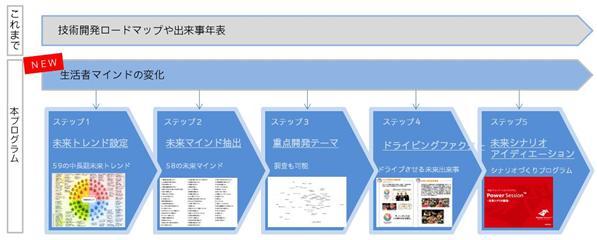Developing the "Future Scenario Creation Program" to envision the future of business based on future trends and consumer mindsets
Dentsu Inc. has developed a program, with the cooperation of Japan Tobacco Inc.※1, that enables companies to create future business scenarios by combining future trends that will change society with the increasingly influential mindset of consumers.
There is a growing corporate need to develop products and services while predicting the near future. However, most future predictions currently available focus on technology development roadmaps and timelines, lacking a focus on consumer mindsets—which should be the primary business concern. The "Future Scenario Creation Program" addresses this gap by focusing on shifts in consumer sentiment to envision business futures. It then uses the backcasting method (strategy planning based on a target future vision) to construct themes for business and product development.
The 5 Steps of the "Future Creation Program"
<Step 1: Selecting Future Trends>
Identify future trends that will impact society. Trends are selected and refined from our proprietary "Mid-to-Long-Term Future Trends 2014"—which depicts the future across four dimensions: "Population & Households," "Society & Economy," "Earth & Environment," and "Science & Technology"—as well as other noteworthy trends.
<Step 2: Extracting Future Mindsets>
Through Dentsu Inc.'s original facilitation program "Power Session R※2," explore what mindsets will emerge among consumers from future trends impacting society. Alternatively, utilize the 1,300+ mindsets generated from our existing 59 future trends and the consolidated "58 Future Mindsets."
<Step 3: Setting Key Development Themes>
Based on Steps 1 and 2, create "Key Development Themes" for your company or industry from the future mindsets. Repeatedly conduct Power Sessions and forced brainstorming to extract the most critical points. These themes can also be validated using the "Future Certainty Survey※3".
<Step 4: Extracting Driving Factors>
From emerging symbolic events and mindsets, extract "driving factors" significantly impacting development themes. Then, visualize these factors in a future map.
<Step 5: Future Scenario Ideation>
Using the development theme and stimulus materials, conduct "future scenario ideation" (idea sketches generated based on development concepts and objectives) for products and services within the relevant category.
The 5 Steps of the Future Creation Program
This program can be utilized by manufacturers and other companies to create future scenarios such as the following.
<Application Examples>
◇Establishing product/service pipelines
◇Formulation of mid-term management and business scenarios
◇ Product and service development targeting future customers
※1 Japan Tobacco Inc. (JT) Tobacco Business Division, Business Planning Office, Innovation Promotion Team: An organization within the JT Group whose mission is to foster sustainable innovation.
※2 Power Session®: Dentsu Inc.'s proprietary facilitation program. Utilizes necessary systems—such as idea-support tools, stimulus materials, and open innovation mechanisms—to generate new innovations.
※3 Future Certainty Survey: Calculates the score difference between responses to two questions—"Do you feel this way now?" and "Do you think you will feel this way in 5 years?"—for 58 future mindsets. This creates a ranking of "Mindsets Likely to Increase in the Future." The top 5 by age group are as follows.
Dentsu Inc. News Release http://www.dentsu.co.jp/news/release/2013/pdf/2013136-1220.pdf
Was this article helpful?

